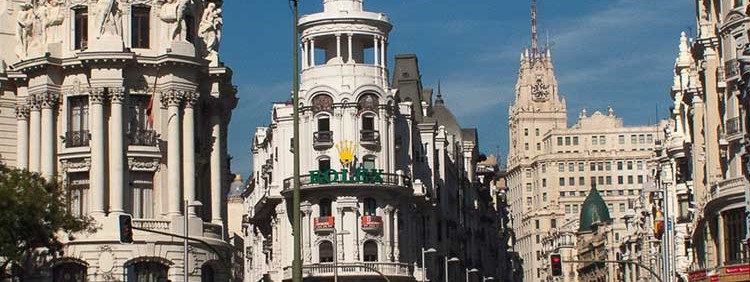Europe’s comfortable capital city
London may be bigger (twice, in fact), Rome more ancient (just the 2359 years head start), Berlin more imposing, and Paris more chic, but of the five big European nations, it is certainly Spain’s capital city, Madrid, that wins most plaudits as a liveable city, for visitors and residents alike. External polls regularly reaffirm the opinion of the madrileños themselves that Madrid is one of the most comfortable large cities one could live in, rankings consistently placing it in the top twenty in the world. One of the reasons is undoubtedly the climate: over 300 days of sunshine a year and an intense blue sky. Madrid also has a cultural vibrancy and a 24-hour lifestyle that one does not find in many other cities – leading it to be dubbed “the city that never sleeps”. Furthermore, despite a total municipal population that is nowadays nudging over 6 million, Madrid gives the sense of being something of a large village, with the locals especially warm and welcoming to the fairly recent influx of people from all over the world. It is also a well-run and wealthy city, third only in terms of GDP behind London and Paris in the EU, and despite Spain’s recent economic downturn Madrid still exudes a dynamism and prosperity to set alongside its history and culture.
It is undoubtedly art that draws most visitors to Madrid. In the so-called “Golden Triangle of Art” one finds perhaps the greatest concentration of European art anywhere in the continent, divided between the world-famous Prado Museum, the modern art collection of the Reina Sofía Museum, and the Thyssen-Bornemisza Museum, which complements the other two with its mixture of late medieval and contemporary art. These three cover practically all Spanish and European art from the 12th to the 20th centuries, from Velázquez to Picasso, Titian to Miró, and it would take days to examine their treasures in detail. Most visitors content themselves with some self-educated wanderings but a private guide, expert in art history, can add immeasurably to the experience of seeing and understanding these great works.
Beyond the “name” galleries and museums, Madrid has a series of new, quirkier, independent arts centres. Foremost is the CaixaForum which, although based in an avant-garde construction using the shell of an old industrial building, exhibits retrospectives of artists from earlier times and has evolved into one of the most-visited museums in Madrid. In the south by the Manzanares river is the gigantic Matadero complex, an old meat market and slaughterhouse converted into a stunning multi-purpose arts centre hosting temporary installations, contemporary theatre, cinema and dance, workshops, lectures, discussions — even Bicycle Maintenance classes! Other galleries, with more classical collections, include the lovely Sorolla Museum, an elegant old mansion where the high-ceilinged rooms display the paintings of Joaquín Sorolla, a prolific c.19 painter whose upbeat and colourful representations of everyday Spanish scenes gained him great popularity; the Royal Academy of Fine Arts of San Fernando, dating back to 1744 and still teaching aspiring artists today, located in a grandiose Baroque palace and with an impressive collection of Renaissance and early modern art (plus works by Goya, who used to be the academy’s director); and the Lázaro Galdiano Museum — the private collection of the millionaire Galdiano, one of Spain’s most passionate collectors of art, Old Masters included, housed in a beautiful palace on the posh Calle Serrano.
Other notable Madrid landmarks include the Royal Palace, with its opulent tapestries; the Royal Theatre with its restored 1850 Opera House; the expansive green “lung” of the city, the Buen Retiro Park, founded in 1631; a large and eclectic spread of national museums, and the old Habsburg quarter centred around the imposing rectangle of Plaza Mayor.
In addition, as befits one of Europe´s greatest party towns, there are endless bars where you can have a “caña” (little beer) and tapas in the many different “barrios” of Madrid: La Latina, Chueca, Lavapiés, Salamanca, Malasaña, among others. For a more peaceful moment, rest in one of the green areas of the city such as the Buen Retiro park, Casa de Campo, Parque del Oeste or even take a stroll along the River Manzanares, where eight kilometres of river parkland and urban beaches were recently restored. However, to gain some respite from the bustle of this energetic city, a good plan is to head out into the mountains, just one hour away, and breathe the fresh air or visit the magnificent historic towns of Madrid’s surroundings, such as Segovia, Ávila and Toledo.
